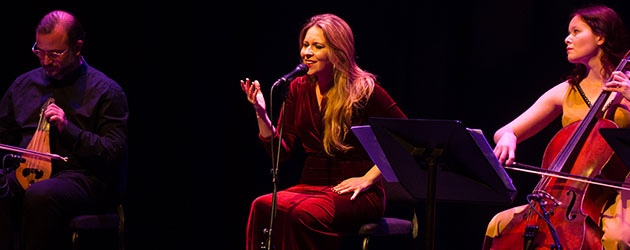Sara Arguijo
Photos: Annemiek Rooymans
Rocío Márquez, Leonor Leal and Agustín Diassera put emotion into «Fantasía para violonchelo y flamenco» which Sunday closed out the Dutch Bienal
Fantasía para violonchelo y flamenco. Cante: Rocío Márquez. Cello: Maya Fridman, Ella van Poucke Kemençe: Derya Türkan Dance: Leonor Leal. Percussion: Agustín Diassera. Multi-instrumentalist: Efrén López. Sunday, January 29th. Muziekgebouw (Amsterdam) Bienal de Holanda. Attendance: Full
On Sunday, the Bienal Flamenco of the Netherlands reached its conclusion with “Fantasía para Violonchelo y Flamenco”, a show co-produced with the Bienal de Cello de Ámsterdam which was billed as one of the strong bets for this festival, in as much as it proposes a dialogue between artists of different musical languages, people who are also stars in their own respective countries. In this case, Spain, Iran, Turkey and Holland.
In this sense, for this show there were no better representatives of flamenco than singer Rocío Márquez, dancer Leonor Leal and percussionist Agustín Diassera. Not only because of their inner questing, their solid reputation, bravery and the good taste they exhibit in any project they undertake, but because they also know each other so well they can look each other in the eye, and feel right at home.
And we emphasize this because yesterday was an artistic communion between Márquez, Leal and Diassera, which saved an elegant well-worked show, that was somewhat cold, overly long, and at times, monotonous. In other words, “Fantasía para…” could have fit perfectly in any series, in or out of flamenco, and would have satisfied the audience thanks to its beauty, and the exquisite nature of the work, but if it triggered any emotion, it was due to the sweetness and devotion the Huelva singer delivers with her singing, to the creativity of movement and subtlety of Leonor and above all else, the exquisite coherence and good taste shown by Agustín, who really took charge on stage.
To put it another way, and I don’t mean to be a cultural chauvinist, in this dialogue it’s flamenco that calls the shots, which is why it was the guajira, the bulería “Me Embrujaste”, the alegrías “La sal le dijo al azúcar” and the siguiriya “Vivo yo con pena” that were the most-applauded pieces. In addition to the Sephardic song “Los Guisados de las Berenjenas” which Rocío made all her own, demonstrating her full vocal command.
The bottom line is, it’s an interesting idea which might benefit from more warmth and some breaking-in. In any case, flamenco was there to back things up, and there was Diassera.
